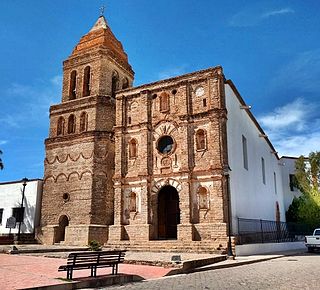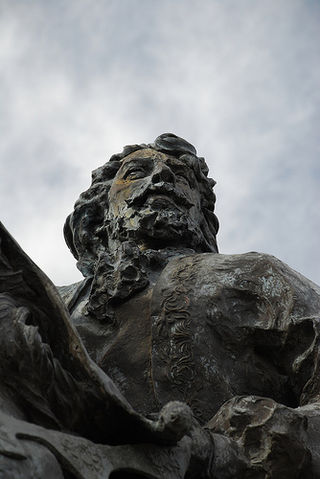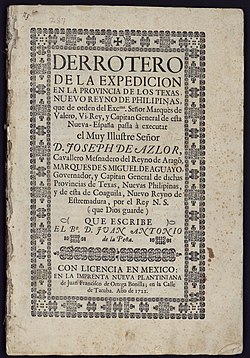
Coahuila, formally Coahuila de Zaragoza, officially the Free and Sovereign State of Coahuila de Zaragoza, is one of the 32 states of Mexico.

Tamaulipas, officially the Free and Sovereign State of Tamaulipas, is a state in Mexico; one of the 31 states which, along with Mexico City, comprise the 32 Federal Entities of Mexico. It is divided into 43 municipalities.
Nueva Extremadura means "New Extremadura" in Spanish, and originates from Extremadura, Spain.

The Spanish Missions in Texas comprise a series of religious outposts established by Spanish Catholic Dominicans, Jesuits, and Franciscans to spread the Catholic doctrine among area Native Americans, but with the added benefit of giving Spain a toehold in the frontier land. The missions introduced European livestock, fruits, vegetables, and industry into the Texas area. In addition to the presidio and pueblo (town), the misión was one of the three major agencies employed by the Spanish crown to extend its borders and consolidate its colonial territories. In all, twenty-six missions were maintained for different lengths of time within the future boundaries of the state of Texas.

Pedro Cebrián y Agustín, 5th Count of Fuenclara, Grandee of Spain, was a Spanish diplomat and viceroy of New Spain, from November 3, 1742 to July 8, 1746.

Teodoro de Croix was a Spanish soldier and colonial official in New Spain and Peru. From April 6, 1784 to March 25, 1790 he was viceroy of Peru.

Arizpe is a small town and the municipal seat of the Arizpe Municipality in the north of the Mexican state of Sonora. It is located at 30°20'"N 110°09'"W. The area of the municipality is 2,806.78 sq.km. The population in 2005 was 2,959 of which 1,743 lived in the municipal seat as of the 2000 census.

Alberto del Canto, formally Alberto Vieira do Canto, was a noble and military Portuguese conquistador who explored the north of Mexico, where he was the founder of several cities.
José de Azlor y Virto de Vera, second Marquis of San Miguel de Aguayo by marriage, commonly known as the Marqués de Aguayo, was the governor of the provinces of Coahuila and of the New Philippines in New Spain between 1719 and 1722. During his tenure, Aguayo retook eastern Texas from New France without firing a shot. He established or reestablished seven missions and three presidios, and quadrupled the number of Spanish soldiers stationed in Texas. Aguayo and his wife were also owners of a very large estate, or latifundio, in Coahuila. His descendants inherited and expanded the landholdings. The Aguayo dynasty continued until 1825.

The Provincias Internas, also known as the Comandancia y Capitanía General de las Provincias Internas, was an administrative district of the Spanish Empire created in 1776 to provide more autonomy for the frontier provinces of the Viceroyalty of New Spain, present-day northern Mexico and the Southwestern United States. The goal of its creation was to establish a unified government in political, military and fiscal affairs. Nevertheless, the Commandancy General experienced significant changes in its administration because of experimentation to find the best government for the frontier region as well as bureaucratic in-fighting. Its creation was part of the Bourbon Reforms and was part of an effort to invigorate economic and population growth in the region to stave off encroachment on the region by foreign powers. During its existence, the Commandancy General encompassed the Provinces of Nueva Navarre, Nueva Vizcaya, Las Californias, Nuevo México, Nuevo Santander, Nuevo Reyno de León, Coahuila and Texas.

The Convent of San Francisco is located at the western end of Madero Street in the historic center of Mexico City, near the Torre Latinoamericana and is all that remains of the church and monastery complex. This complex was the headquarters of the first twelve Franciscan friars headed by Martín de Valencia who came to Mexico after receiving the first authorization from the Pope to evangelize in New Spain. In the early colonial period, this was one of the largest and most influential monasteries in Mexico City. It was built on the site of where Moctezuma II’s zoo once was. At its peak, the church and monastery covered the blocks now bordered by Bolivar, Madero, Eje Central and Venustiano Carranza Streets, for a total area of 32,224 square metres.
Isidro Félix de Espinosa (1679–1755) was a Franciscan missionary from New Spain who participated in several expeditionary missions throughout the province of Tejas. He was the president of the missionaries from the College of Santa Cruz de Querétaro.

Francisco Cuervo y Valdés was a Spanish politician who governed Nuevo León (1687-1688), Nueva Extremadura (1698–1703), New Philippines (1698–1702), and Santa Fe de Nuevo México (1704–1707).
Pedro de Rivera y Villalón was a brigadier general in the Spanish army, who was sent to New Mexico in 1724 to study the presidios near Louisiana.

General Vito Alessio Robles was a Mexican military officer, engineer, writer, journalist, diplomat, and academic who participated in the Mexican Revolution. He was one of the country's leading historians, as well as a politician, serving as a senator and opposition party leader. His work on the history of Coahuila y Tejas, in three volumes, is notable. He was temperamentally a public prosecutor and as a critic he spoke and wrote with total frankness. He is credited as the first generation of romantic revolutionaries of Mexico who dreamed and put to action the civic movement which would ensure better opportunities open to the people of Mexico.

Carlos Castañeda was a historian, specializing in the history of Texas, and a leader in the push for civil rights for Mexican-Americans.
Juan (Francisco) de Céspedes Ruiz was a Spanish conquistador who is known as the founder of the town of Pasca, Cundinamarca, in the south of the Bogotá savanna, Colombia. De Céspedes arrived in the Americas in 1521 and participated in the conquest of the Tairona and the foundation of Santa Marta under Rodrigo de Bastidas. From 1542 to 1543 and in 1546 he served as mayor of Bogotá and after that until 1570 as lieutenant general of the first president of Colombia. Juan de Céspedes married Isabel Romero, one of the first Spanish women who arrived at Colombian territories and had two legitimate sons and one daughter. His date of death is uncertain; in late 1573 or 1576.

Antonio de Lebrija was born in 1507, in Alcántara, Extremadura, Spain; and died in 1540, in Brozas, also in Extremadura. He was a Spanish conquistador who participated in the Spanish conquest of the Muisca and the Chimila peoples. He was the treasurer of the conquest expedition which left Santa Marta in April 1536 following the high quality salt trail, the Camino de la Sal, along the Suárez River up the slopes of the Eastern Ranges of the Colombian Andes towards the Muisca Confederation.
José Domingo Ramón was a Spanish military man and explorer who founded several missions and a presidio in East Texas to prevent French expansion in the area.
Juan Agustín Morfi was a Franciscan friar, born in Asturias, Spain, in 1735, who died in Mexico, New Spain, in 1783. He is considered the most important chronicler and historian of the New Philippines; Mariano Errasti ranks Morfi among the most prodigious figures in five centuries of Franciscan work in America.














